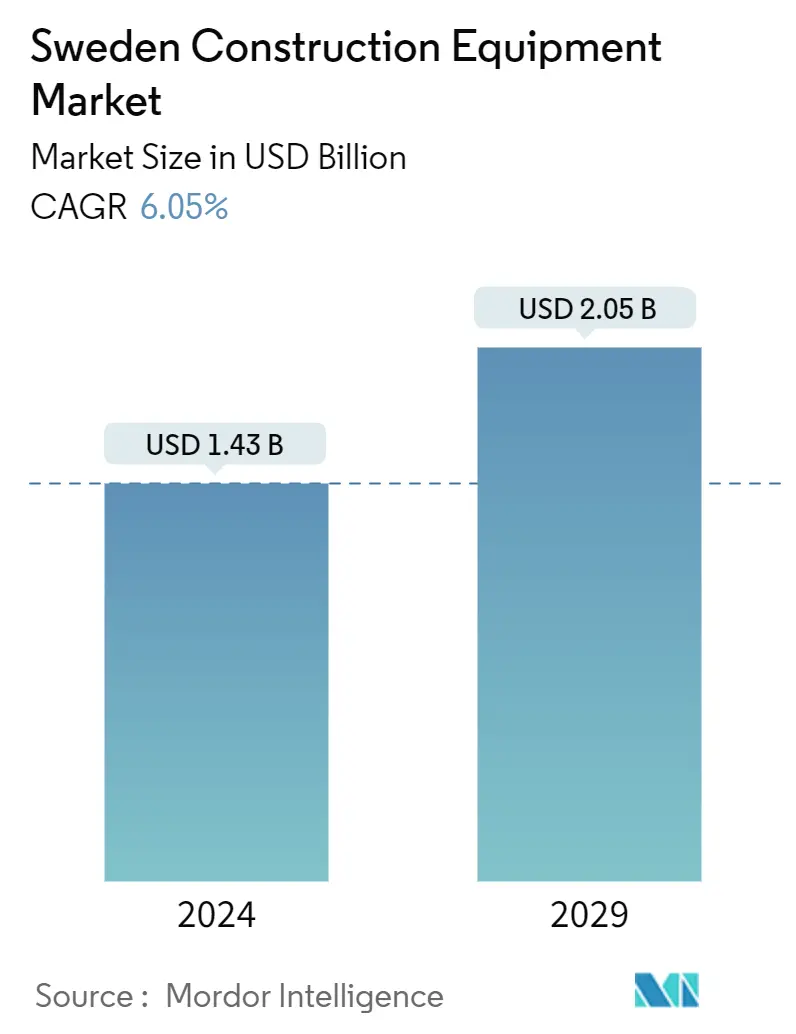Market Size of Sweden Construction Equipment Industry

| Study Period | 2019 - 2029 |
| Base Year For Estimation | 2023 |
| Market Size (2024) | USD 1.43 Billion |
| Market Size (2029) | USD 2.05 Billion |
| CAGR (2024 - 2029) | 6.05 % |
| Market Concentration | Medium |
Major Players
*Disclaimer: Major Players sorted in no particular order |
Need a report that reflects how COVID-19 has impacted this market and its growth?
Sweden Construction Equipment Market Analysis
The Sweden Construction Equipment Market size is estimated at USD 1.43 billion in 2024, and is expected to reach USD 2.05 billion by 2029, growing at a CAGR of 6.05% during the forecast period (2024-2029).
Increasing government spending on infrastructural development, rising investments in the construction and mining sector, and developments in road transportation infrastructure owing to the surge in population and urbanization serve as the major determinants for the growth of the construction market in Sweden, which, in turn, positively contributes to the surging demand for construction equipment across the country.
Sweden boasts of one of the highest urbanization rates in the European region, with 88% of its overall population residing in urban areas as of 2022. The high urbanization rate leads to consumers availing various private and public transportation mediums for their commutes, which leads to higher congestion in these cities. Therefore, road infrastructure development has become a major focus area for the Swedish government. Coupled with that, developments in cross-border road connectivity serve as another deterministic area for enhancing the trade ecosystem of a nation. Hence, with the government's increasing focus on developing its road infrastructural network, there exists a massive demand for construction equipment in the country.
For instance, the Swedish government is highly focused on investing large sums in the Stockholm Bypass project to develop a new motorway linking southern and northern Stockholm and create a new route for the European E4 highway past Stock. This project aims to manage the ever-increasing road congestion that accompanies the population growth in Stockholm, which is expected to reach 2.5 million by 2030.
One of the major challenges faced by the construction equipment industry in Sweden is the high cost of replacement and maintenance of the equipment, which becomes a financial burden for construction companies and equipment rental companies. Since these equipment products operate for a longer duration and need to sustain heavy loads at all times, there is constant wear and tear of the equipment, which needs frequent maintenance checks and, in extreme cases, complete replacement of the product.
Thus, construction companies and equipment rental companies owning these machinery need to spend hefty sums to make sure that these equipment are operating efficiently at all times, which increases their cost of operation. Coupled with that, falling demand for housing in Sweden, owing to the increasing interest rate and high mortgage debt, is negatively impacting the housing sector development, which in turn deters the growth of the construction equipment market in the country.
The Swedish government follows old and rigid policies for controlling rent, which negatively impacts the building of new houses for rent due to the low-profit margin for the house owners and builders. Further, the central bank's strategy to increase interest rates is deterring consumers from taking further debts for constructing new houses, thereby affecting the construction equipment market in Sweden.
The government's pragmatic initiatives for infrastructural development across Sweden are anticipated to contribute to the surging demand for construction equipment in the coming years. For instance, in May 2023, the Swedish Transport Administration announced the construction of a permanent electric road, which is expected to lead to an expansion of a further 3,000 km of electric roads in the country by 2035. The administration announced that it had identified the E20 highway as the ideal location for this pioneering endeavor, a 13-mile (21 km) stretch extending from Hallsberg to Örebro between Stockholm and Gothenburg, which is expected to be accessible to the public from 2025-2026. With increasing investment to enhance the infrastructural capability of Sweden, there will exist a massive demand for construction equipment during the forecast period.
